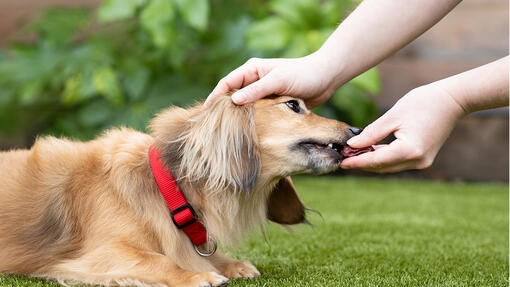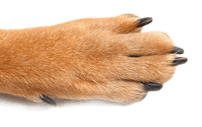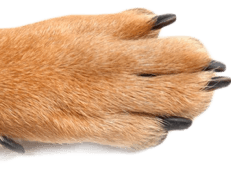
Teach your dog to lie down by luring them from a sit with a treat, marking and rewarding the action. This command is invaluable for behaviour management and public settings, but crucially, never use it to force your dog into stressful situations.
Once your puppy knows their name and can pay attention to you when they hear it, and now they know how to sit when you ask them to, the next exercise that most people teach is to lie down.
This is another easy exercise for owners to teach and for most dogs to learn, and it is one that has plenty of real life uses.
Why Should I Teach My Dog to Lay Down?
Learning to lie down when asked is a really useful exercise that will come in helpful in lots of day to day situations.
First of all, it gives you a simple thing to ask your dog to do that is incompatible with less desirable behaviours, such as jumping up, trying to steal food or leaping on people trying to come in the door. While a sit will work for this, a down is even better as the dog is totally on the floor.
Like the sit, this means you can ask your dog to do something that you can reward in certain situations rather than them doing something you would rather they didn’t or that could be dangerous.
For people who are worried about dogs, seeing a dog lying quietly makes them seem far less scary, and it instantly reassures people that they are under control.
If you are going to take your dog out and about to pubs or cafes, having a dog who will lie down is important – and your vet will appreciate it if your dog will lie down for examination.
For dogs who find sitting difficult or uncomfortable, the down is a good first exercise to teach instead.
It is also the basis for a lot of other training exercises – and is especially useful when you are training a stay or a wait such as before going through a door or jumping out of the car.
What Equipment is Needed to Teach a Dog to Lie Down?
To start this exercise, nothing is needed except:
- Some small dog treats that your dog loves (ideally smelly)
- A quiet place to train that doesn’t have a slippery floor (carpet or a secure rug is perfect – as is grass).
Step by Step guide to Training a Dog to Lie Down
- Start by showing the dog exactly what you want them to do by luring them with a treat.
- Start with your dog in a sit – as they are already halfway there.
- Hold a treat in your hand close to the end of your dog’s nose so they can smell it (if you have a small dog, you might need to sit on the floor or on a chair, so you are not looming over them).
- Once they know it’s there and are keen to get it, bring your hand down slowly (with their nose following it) to between their front paws.
- Keep your hand over the treat (flat to the floor) so they know it’s still there but can’t quite get it. Eventually, they will find it is more comfortable to do this lying down. You might have to change your position a few times to find out what works best for you.
- The instant they lie down, use your marker word (or clicker if you are using one) and lift your hand and give the treat.
- Repeat this a lot until the moment you lower your hand; your dog lies down every time. Some dogs can learn this in a few repetitions; others will take a few days.
- Now move on to using your hand in the same way but without a treat in it. When your dog lies down, use your marker word and give them a treat from your other hand. This is an important step as it means they are lying down on a hand signal and not just following the food.
- At this point you can add the cue word (“down” or “drop” – ‘drop’ can be useful if you think you might say “down” to your dog when you want them to get off the sofa or not jump up!) but use this as your dog is lying down and not before. To start with all you are aiming to do is link the word with the action.
- Slowly you can reduce how big the hand signal is, so your dog is lying down with the smallest of hand signals.
- Practise – adding the cue word every time your dog lies down. Before long, you will be able to use the cue word alone to ask for the down.
- Now it’s time to generalise the behaviour – in other words, do it in lots of different places and times. This can be different rooms, the garden and out on walks (first only when it’s quiet and then with light distractions). With each new location, start at the beginning and work through all the steps – although it should only take a few repetitions.
Next steps
As always with training, it is now all about practise.
Once your dog is doing this reliably, you can begin to reduce how often you reward them – but every now and then, revisit the down in your training practice and sometimes give unexpected rewards to keep the behaviour refreshed and reinforced.
You can go on to teach your dog to lie down on a mat – which you can then take with you when you go out and about.
Training Tips
If your dog finds this difficult at first and keeps back up, try teaching this with something behind them like a sofa.
If they scratch or bite at your hands in a way that is painful, you can use a glove or move your hand out of the way before trying again.
If you think your dog is getting frustrated because they don’t know what you want, start by rewarding ‘half downs’ or any move downwards.
Like the sit, use it carefully – especially to start with – when out and about. Don’t use it to make your dog endure something they find stressful (like having strangers fuss them or in situations where they are highly aroused). It is far better to recognise these situations and remove your dog from them. Lying down in a stressful situation can make a dog feel more vulnerable – and so more stressed. This is especially true in encounters with other dogs as making your dog lie down will prevent them from showing appropriate body language.
Success!
Well done. In a few easy steps, you have taught your dog one of the most useful behaviour exercises – to lie down when you ask them. You are well on the way to having a well-trained, polite dog.




